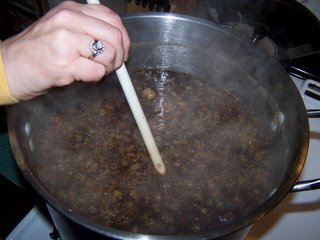
I spent this past Saturday teaching a couple of friends how to brew beer. Since it's too cold outside to run the garden hose, I moved the operation in doors and went with extracts rather than whole grain. This is the easy way to brew, and the best way to get started. The quality of malt extracts has improved greatly over the past few years and you can brew every bit as good of a beer from them as you can from starting with whole grains (I'll save that for this next spring or summer).
Anyway, to start off we brewed up Lightnin's favorite recipe. It's a knock off of Sam Adam's and actually scored higher than Sam's Boston Lager in a blind taste test. We named it "Sammy Jo's Lager" (Sammy Jo is a nick name given to Lightnin by friends, but that's another story). This recipe calls for two 3lb cans of malt extract: 1 light, and 1 amber. It also calls for 1lb of carapils (an adjunct malted grain, I'll explain in a minute), and 3oz of leaf hops (1oz Kent Goldings, 1oz Hallertau, and 1oz Tettnang), and a tube of liquid German Lager yeast.
The equipment you'll need for this is a 4 to 5 gallon pot (either stainless or speckeled enamel, a canning pot works great, if you have at least two of these it makes brewing much easier), a smaller pan capable of holding 1 gal hot water, a mesh strainer (capable of holding 1lb of wet grain, and later hops), a long handled spoon, 2 glass carboy fermentors (water cooler jugs, 1-6.5 gal and 1-5 gal), 2-rubber stoppers, 2-airlocks, a transfer (racking) tube, bleach (for sanitization), water, snacks, beer to drink, and patience. (Most of this equipment can be purchased at the brewing supply store where you get the malt, hops, and yeast. You can piece it together yourself for cheaper, but it does take a bit of leg work to find it all).
First, sanitize the primary fermentor (6.5 gal) with bleach water (1/2 cup bleach to 5 gallons water, minimum contact time of 30 minutes). Add somewhere between 1/2 and 3/4 cup bleach to the fermentor and fill to the brim with cold tap water, allow to stand for a minimum of 30 minutes. I usually do this before I go any further and then dump out the bleach water and rinse the fermentor with hot tap water just prior to the finishing steps (detailed below).
Next, get a gallon of water boiling in the smaller pan. While this is heating, crack the carapils. This can be done with a rolling pin or mallet by placing the grain into a plastic bag and rolling over it, or smacking with the mallet. You only need to crack the husk around the grain so that water can get in. I have a Corona mill that works pretty good, but it can sometimes grind the grain too much so you have to constantly adjust the gap setting when you change grains (more on that when I write about all grain brewing). Once the water and grain is ready, add the grain to the water, turn off the heat, stir and allow to sit for 10 minutes. After 10 minutes pour through the strainer into the big pot (Brew Kettle). Bring an additional gallon of water to boil in the small pan, this will be used to rinse (Sparge is the brewing term) the grains, keeping the rinsings in the brew kettle.

Next (while waiting for the above water to heat and the grains to drain) fill the sink with hot water, remove the labels from the cans of malt, and soak the malt cans on their sides. This will warm the malt to allow it to flow out of the cans. The syrup is a bout as thick as molasses, but sweeter (go ahead and taste it, you'll want to put it on ice cream!). Open and drain the malt into the brew kettle, rinse cans with hot water pouring the rinses into the brew kettle, stir to dissolve. Now bring this mixture, which from here out will be refered to as wört, to a boil. (These are actual brewing terms, I'm not making this up!)

When bringing the wört to a boil keep an eye on the brew kettle! The proteins in the malt syrup will form a thick foamy head that, if left unattended, will boil over onto the stove creating a much bigger mess than you will ever want to see! (not that I have personnally experienced this, yeah right)
Once the wört comes to a boil, add the first addition of the hops (Kent Goldings), and allow to boil for 45 minutes, stirring occasionally. It is important to maintain a good rolling boil at this point, but not an all out splatter the kitchen bubbling boil! When the 45min is up, add the

second hop (Tettnang) and a pinch of Irish Moss (a natural floculate: helps particulate material to sink to the bottom during fermentation), and allow to continue boiling for 15 minutes. After 15 min. add the Hallertau hops, turn the heat off, and allow to stand for 5 minutes.
Now you have a few choices: 1) if you have another, clean non-aluminum, 3 or 4 galllon vessel you can add about 1/2 of a small bag of ice to the pan and then pour 1/2 the wört through the mesh strainer onto the ice, repeat this twice, pouring the strained wört into the fermentor, 2) slowly add ice to the current brew kettle, then

pour through the strainer into the fermentor, or 3) add about 2 gallons of cold water to the fermentor, then strain the hot wört into the fermentor. Attach the stopper and airlock (also sanitized with bleach water).
This last part is the most criticle, next to the sanitization step, make sure that the wört has cooled to below 80 deg F and add the yeast. Replace the airlock and partially fill, the airlock) with either bleach water or Vodka. This serves as a filter to allow the release of carbon dioxide, created during fermentation, and keeps microbes (the little bacteria/yeasts/molds that are floating around in the air just waiting to feast on your malt sugar solution). Place the fermentor in a dark cool place (usually a centrally located closet works fine). If you've done everything correctly, and the yeasty boy's like you, you should hear the music of the airlock bubbling away within a few hours.
In a few days, might take a week, the bubbling will stop. It is now time to transfer to the secondary fermentor (5 gal carboy). Sanitize the secondary, the second airlock, and the racking tube with bleach water (1/2 cup bleach to 5 gal water, minimum contact time of 30 minutes). Drain and rinse the equipment with hot water. Set the primary fermentor (the one with young beer in it) on a counter top. Set the secondary on the floor below. Siphon from the primary into the secondary. Attach the airlock and allow to sit in a dark cool place for another week or so. At this point you're ready to bottle, and that my friends is the topic of a future post!

Cleanup isn't too bad either, I usually try to clean as I go so that when the yeast has been added, I'm done and can sit to enjoy a good brew while I anticipate how wonderful the one I just made will be!
I've been brewing beer since July 1993 with over 130 batches under my belt (ok it's obvious by the pictures that most of those are just above my belt), and have been a card carrying beer judge since 1997. So If you're interested in more information around brewing, please let me know and I'd be more than happy to share my knowledge, experience, and some good books that you can check into to get started. Special thanks to our friends: Ollie, Mary, and Rod for hanging out on a Saturday and making the brew day a fun time!



 When bringing the wört to a boil keep an eye on the brew kettle! The proteins in the malt syrup will form a thick foamy head that, if left unattended, will boil over onto the stove creating a much bigger mess than you will ever want to see! (not that I have personnally experienced this, yeah right)
When bringing the wört to a boil keep an eye on the brew kettle! The proteins in the malt syrup will form a thick foamy head that, if left unattended, will boil over onto the stove creating a much bigger mess than you will ever want to see! (not that I have personnally experienced this, yeah right) second hop (Tettnang) and a pinch of Irish Moss (a natural floculate: helps particulate material to sink to the bottom during fermentation), and allow to continue boiling for 15 minutes. After 15 min. add the Hallertau hops, turn the heat off, and allow to stand for 5 minutes.
second hop (Tettnang) and a pinch of Irish Moss (a natural floculate: helps particulate material to sink to the bottom during fermentation), and allow to continue boiling for 15 minutes. After 15 min. add the Hallertau hops, turn the heat off, and allow to stand for 5 minutes. pour through the strainer into the fermentor, or 3) add about 2 gallons of cold water to the fermentor, then strain the hot wört into the fermentor. Attach the stopper and airlock (also sanitized with bleach water).
pour through the strainer into the fermentor, or 3) add about 2 gallons of cold water to the fermentor, then strain the hot wört into the fermentor. Attach the stopper and airlock (also sanitized with bleach water). If you remember the 60's, or early 70's, then you are probably humming the song referenced in the title.
If you remember the 60's, or early 70's, then you are probably humming the song referenced in the title.